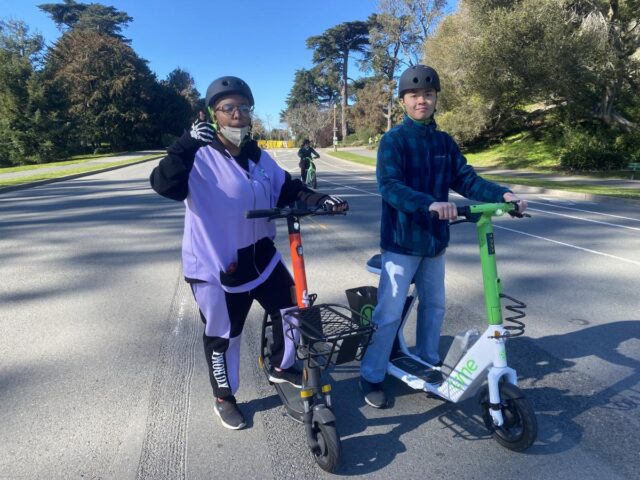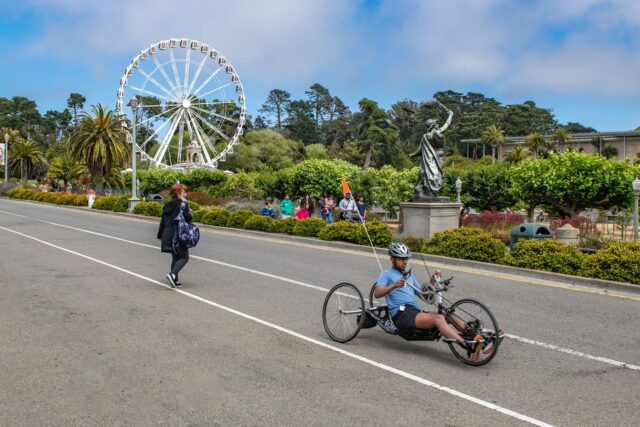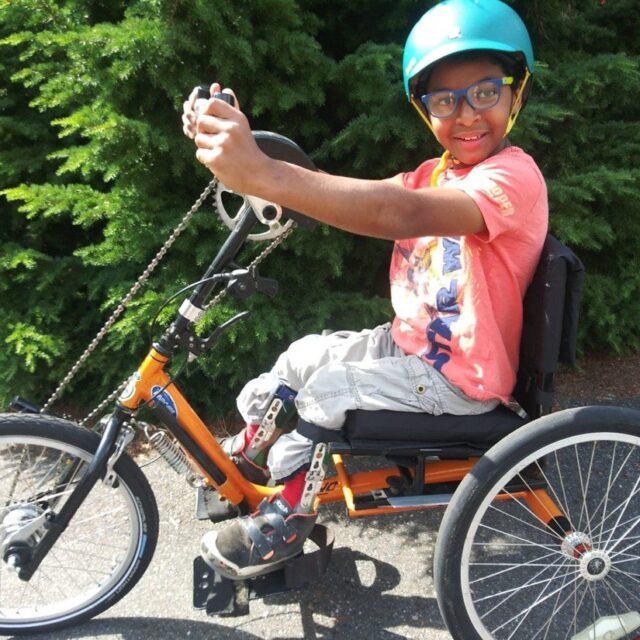How San Francisco Does Adaptive Shared Micromobility
by Kiran Herbert, Communications Manager
December 15, 2023
The city maintains adaptive programming for both scooters and bikes, believing that all emerging mobility services should offer equitable and disabled access.

Students of AcessSFUSD, a special education division of the San Francisco Unified School District, test adaptive scooters in Golden Gate Park.
San Francisco is a smaller city than its renown implies. With under a million people, it’s 47 square miles — or roughly 7×7 miles in each direction. The relatively contained footprint and the emphasis on building a safe, connected bike network, make San Francisco something of a golden city for shared micromobility. The small size, however, also means that when scooters first landed in the city in 2017 and began blocking the pedestrian right-of-way, there was an immediate uproar.
“That was our biggest access issue with the scooters at first,” says Forest Barnes, transportation planner at San Francisco Municipal Transportation Agency (SFMTA). “The city handled that by ensuring there were enough bike racks and then requiring all scooters to be locked to one.”
From the get-go, SFMTA worked with various disability groups — including the Multimodal Accessibility Advisory Committee, the Paratransit Coordinating Council, and the Mayor’s Disability Council — to ensure scooters weren’t reducing access for people with disabilities. By 2020, when the city officially launched its adaptive scooter program, the focus had shifted to providing a service for adaptive riders as well.
That shift resulted in two pieces of policy for adaptive scooters. One, known as the Complimentary Adaptive Program, functions as an on-demand adaptive device library where anyone can check out an adaptive vehicle from one of the city’s permitted companies (currently Spin and Lime) for a longer period of time. This program, which as the name suggests is completely free, offers residents a choice of trikes and seated scooters and allows for custom pick-up and drop-offs.
The second piece of policy required all scooter operators to offer on-street adaptive scooters. These scooters have seats and baskets to provide more comfort and stability and can be rented through the Lime and Spin apps, just like any other scooter. While the SFMTA policy requires that 5% of each operator fleet is seated, in reality, there are often not that many on the street due to theft.
“These vehicles get stolen frequently and that’s a big problem for the companies,” says Barnes. “We’re currently considering how to move forward.”
As part of that process, the city will continue to consult with its partners in the disability community throughout the winter, gauging what elements of the city’s adaptive scooter program have been working and what needs to be improved. In October, Lime and Spin hosted an adaptive scooter event to offer folks the chance to get hands-on experience with a range of adaptive scooters in Golden Gate Park. While there’s no regular cadence or a requirement from SFMTA for the scooter companies to host events, according to Barnes, there tends to be at least one adaptive outreach event every six months or so, mostly in Golden Gate Park
In early 2023, SFMTA also solicited feedback from teachers and students of AcessSFUSD, a special education division of the San Francisco Unified School District. The group gathered on JFK Drive in Golden Gate Park to test-ride adaptive scooters from Lime and Spin, offering feedback about a variety of design elements, including the wheels, seat, throttle, basket location, foot plate width, and the ease of getting started.
Since the pandemic, the 1.5 miles of JKF Drive that run through Golden Gate Park has been closed to cars, a change that was made permanent in 2022. Many of those who were against the car-free ordinance cited people with disabilities’ inability to access the park as a major barrier to use. To ensure those with disabilities can still drive to the park, a new, all-accessible parking lot was created in the heart of Golden Gate Park with 20 free blue zone spaces reserved for those with disabilities.

An adaptive cyclist on JFK Drive in Golden Gate Park.
Not coincidentally, the renovated Golden Gate Bandshell Parking Lot is also the launch site for the city’s permanent adaptive cycling program. Launched in the summer of 2022 following an incredibly successful pilot, the free program matches people with disabilities to adaptive bicycles by advance reservation. The adaptive bike program is open from 12-4 pm on the first and third Saturdays of the month in Golden Gate Park and on the second and third Saturdays at the Great Highway at the end of Judah Street, which offers participants another car-free stretch of road to enjoy.
The program is a partnership between SFMTA, San Francisco Recreation & Parks, and the Bay Area Outreach and Recreation Program (BORP), a local nonprofit that provides and promotes recreation activities for people with disabilities. BORP hosts one of the largest collections of adaptive bikes in the world, including handcycles, recumbent bikes, side-by-side tandems, and other models that are available to children, youth, and adults with physical and sensory disabilities, as well as their family and friends.
Between the adaptive scooter program and the adaptive cycling program, riders with disabilities have a variety of ways to participate in shared micromobility. According to Barnes, SFMTA’s strategy has been to work in unison with nonprofits and operators to better serve adaptive riders. “We’re all working together to expand access to non-car mobility,” he says, citing the fact that equity and disability access are two cornerstones of the SFMTA’s Guiding Principles for Emerging Mobility Services. “We’re all aligned on that.”
Of course, there’s always room for improvement. In addition to ensuring there are always seated scooters available on the streets for people, Barnes would like to see the city’s adaptive programs publicized more. He also thinks there is more room for collaboration between the adaptive bike and scooter programs, as well as an opportunity for operators to bring a wider variety of mobility options to people. As SFMTA gears up for its next scooter permitting round next spring, it’s also looking at what other cities are offering when it comes to adaptive micromobility.
“People weren’t happy when scooters first came out and the city has worked hard to tamper down the negative externalities they brought — we’ve worked hard to make it accessible,” says Barnes. “It’s all a work in progress.”
The Better Bike Share Partnership is funded by The JPB Foundation as a collaboration between the City of Philadelphia, the National Association of City Transportation Officials (NACTO), and the PeopleForBikes Foundation to build equitable and replicable bike share systems. Follow us on LinkedIn, Facebook, Twitter, and Instagram, or sign up for our weekly newsletter.



